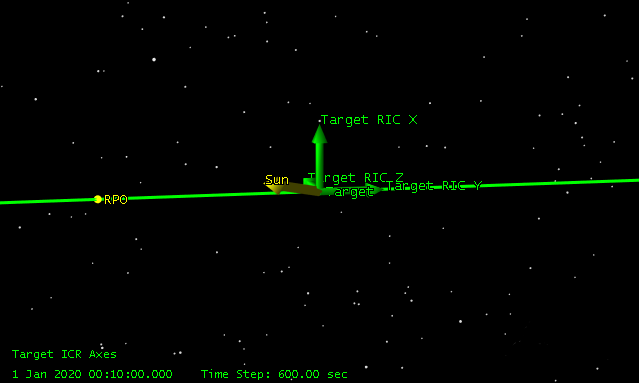VBar RPO Sequence
The VBar RPO sequence places the chase satellite in a VBar relative orbit. The sequence moves the satellite from its current position to the starting point of the VBar via a set of forced-motion waypoints. By default, these move the satellite in a near-straight line along the path connecting the current relative position to the start position on the VBar. If you prefer a simple hop instead of a series of waypoints, set the Way_MaxDegrees parameter to a large value (>180 deg).
The VBar relative orbit is a stable relative orbit requiring no station-keeping if forces are equal on both the target and the chase satellites. Following this sequence, you can use either the Coast RPO (for matching force models) or Maintain_VBar (if differential forces exist) to propagate the VBar forward in time.
The following picture shows an initial position on the VBar.

Sequence parameters
| Option | Description |
|---|---|
| Desired_InTrack | Enter, in distance units, the desired VBar relative position. |
| Transfer_Duration | Enter the transfer time from current position to the start of the VBar. |
| Way_MaxDegrees | Enter, in angle units, the maximum spacecraft degrees between hops for the forced motion part that connects the current position to the start of the VBar. |
| Engine_Name | Enter, as a string, the name of the finite maneuver engine model. |
| Maneuver_Type | Select the type of maneuver, "Impulsive" or "Finite," from the drop-down list. |
| WhoAmI | Enter, as a string, the name of the current satellite. |
| ThisSequence | Enter, as a string, the name of this sequence. This is nominally VBar, but if you insert the sequence multiple times in the MCS, Astrogator adds a monotonically increasing number to the end of the name (VBar1, VBar2, etc.). |